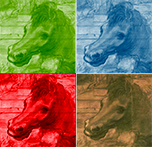MC-ICPMS ionizes an element in a plasma (atmospheric conditions) and transfers the sample into a mass spectrometer where has laser ablation capability in combination with conventional liquid inlet. Samples are either ablated and directly inlet into a magnetic sector mass analyser to separate the ions based on their mass to charge ratio. Samples are generally subject to chemical purification before analysis but some can be ablated with a laser directly into the MC-ICPMS. The instrument has 2 types of ion detection systems (9 Faraday with 1010, 1011 and 1013 Ohm resistors; and secondary electron multipliers providing the capability to measure a wide range of ion beam intensities. This is augmented by sampling can be undertaken using micro drilling, off site in situ laser ablation as well as conventional dissolution of organic and inorganic material. The instrument is routinely used for Pb-Nd-Fe-Si-Th-U-B-Li-Cu-Zn-Mg isotope analyses but many additional elements have and can be analysed. System includes a second mass filter to allow the determination of extreme isotope rations (> 106); e.g. for U-series determinations. the 1013 Ohm resistors allow Pb isotope determination of 100 pg samples.
Fields of application
-
Cultural heritage
archaeological object and site, architecture, art, decorative arts, mosaics, painting, sculpture, textile
-
Natural heritage
animal product, botanic collection, fossil, mineral, shell, skeleton, taxidermy collection
Materials
-
inorganic
ceramic (clay/mud brick/terracotta/earthenware/stoneware/porcelain), glass, stone, metal and metallurgical By-Products, pigment
-
organic
animal parts, wood, paper, textiles
TOOLS

Neptune with multiple ion counters, and 1 10˄13 Ohm resitor
